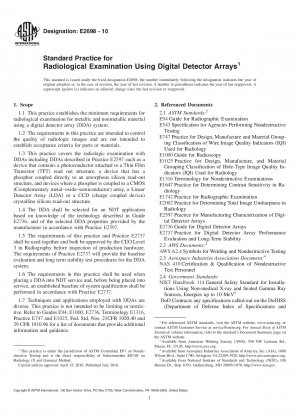ASTM E2698-10
Standard Practice for Radiological Examination Using Digital Detector Arrays
- Standard No.
- ASTM E2698-10
- Release Date
- 2010
- Published By
- American Society for Testing and Materials (ASTM)
- Status
- Replace By
- ASTM E2698-18
- Latest
- ASTM E2698-18e1
- Scope
This practice establishes the basic parameters for the application and control of the digital radiologic method. This practice is written so it can be specified on the engineering drawing, specification, or contract. It will require a detailed procedure delineating the technique or procedure requirements and shall be approved by the CEO.
1.1 This practice establishes the minimum requirements for radiological examination for metallic and nonmetallic material using a digital detector array (DDA) system.
1.2 The requirements in this practice are intended to control the quality of radiologic images and are not intended to establish acceptance criteria for parts or materials.
1.3 This practice covers the radiologic examination with DDAs including DDAs described in Practice E2597 such as a device that contains a photoconductor attached to a Thin Film Transistor (TFT) read out structure, a device that has a phosphor coupled directly to an amorphous silicon read-out structure, and devices where a phosphor is coupled to a CMOS (Complementary metal–oxide–semiconductor) array, a Linear Detector Array (LDA) or a CCD (charge coupled device) crystalline silicon read-out structure.
1.4 The DDA shall be selected for an NDT application based on knowledge of the technology described in Guide , and of the selected DDA properties provided by the manufacturer in accordance with Practice E2597.
1.5 The requirements of this practice and Practice shall be used together and both be approved by the CEO Level 3 in Radiography before inspection of production hardware. The requirements of Practice will provide the baseline evaluation and long term stability test procedures for the DDA system.
1.6 The requirements in this practice shall be used when placing a DDA into NDT service and, before being placed into service, an established baseline of system qualification shall be performed in accordance with Practice .
1.7 Techniques and applications employed with DDAs are diverse. This practice is not intended to be limiting or restrictive. Refer to Guides E94, E1000, , Terminology E1316, Practice E747 and E1025, Fed. Std. Nos. 21CFR 1020.40 and 29 CFR 1910.96 for a list of documents that provide additional information and guidance.
ASTM E2698-10 Referenced Document
- ASTM E1000 Standard Guide for Radioscopy
- ASTM E1025 Standard Practice for Design, Manufacture, and Material Grouping Classification of Hole-Type Image Quality Indicators (IQI) Used for Radiology
- ASTM E1316 Standard Terminology for Nondestructive Examinations
- ASTM E1647 Standard Practice for Determining Contrast Sensitivity in Radioscopy
- ASTM E1742 Standard Practice for Radiographic Examination
- ASTM E2002 Standard Practice for Determining Total Image Unsharpness in Radiology
- ASTM E2597 Standard Practice for Manufacturing Characterization of Digital Detector Arrays
- ASTM E2736 Standard Guide for Digital Detector Array Radiography
- ASTM E2737 Standard Practice for Digital Detector Array Performance Evaluation and Long-Term Stability
- ASTM E543 Standard Practice for Agencies Performing Nondestructive Testing
- ASTM E747 Standard Practice for Design, Manufacture and Material Grouping Classification of Wire Image Quality Indicators (IQI) Used for Radiology
- ASTM E94 Standard Guide for Radiographic Examination
- AWS A2.4 Standard Symbols for Welding, Brazing and Nondestructive Examination Simbolos Normalizados para Soldeo, Soldeo Fuerte y Examen No Distructivo Spanish
ASTM E2698-10 history
- 2018 ASTM E2698-18e1 Standard Practice for Radiographic Examination Using Digital Detector Arrays
- 2018 ASTM E2698-18 Standard Practice for Radiographic Examination Using Digital Detector Arrays
- 2010 ASTM E2698-10 Standard Practice for Radiological Examination Using Digital Detector Arrays
